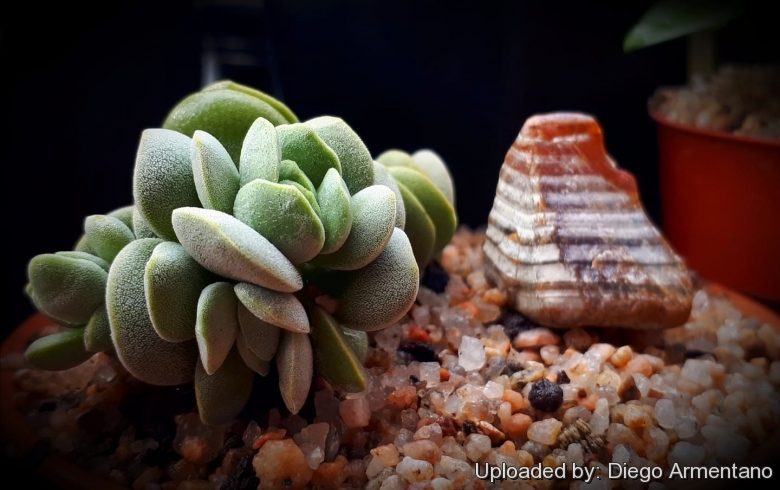
Crassula sericea var. velutina Photo by: Diego Armentano
Origin and Habitat: Southern Namibia, Republic of South Africa (Northern Cape, Western mountains) on both sides of the Orange River. Crassula sericeaSN|35242]]SN|35242]] var. velutina is knows from five subpopulations. A few more are likely in unexplored, inaccessible mountains within the range of this taxon.
Habitat and ecology: Succulent Karoo. This species is rarely found in rock crevices on quartzite outcrops, mainly on the southern or south-western aspect on high peaks. It is s restricted to high-altitude rock crevices, therefore unlikely to be threatened. It flowers from winter to early spring (September – November).
Synonyms:
See all synonyms of Crassula sericea
Description: Crassula sericeaSN|35242]]SN|35242]] var. velutina differs from var. sericea for its smaller size (less than to 15 cm tall including inflorescences), and decumbent to erect, sparingly branched growth. The stems are very short (usually less than 30 mm long) with larger flattened leaves with velvety hairs. Using a jewellers eye piece the very tiny hairs appears dense and upright. The yellow pointed petals usually lack dorsal appendages.
Stems. Branches short, to 6.5 cm tall. Internodes 5-10 mm long.
Leaves: 8-10 pairs of ascending leaves are borne at the ends of the branches. The leaves are obovate to broadly ovate, 20-30 mm long, 10-20 mm wide, flattened, fleshy, to 5 mm thick, upper face flat to somewhat concave, lower face convex, surface with erect to spreading dense white hairs, tip obtuse, often mucronate.
Inflorescences. Erect thyrses to 10 cm long and 9 cm wide, with spreading glomerate dichasia 8-10 mm in diameter. Peduncles reddish, 2-6 cm long.
Flowers. Calyx lobes triangular, 1 mm long. Corolla 3 mm long, white, tubular, lobes oblong, about 2 mm long, acuminate, recurved, without dorsal appendages.
Chromosome number: 2n = 14
Subspecies, varieties, forms and cultivars of plants belonging to the Crassula sericea group
 Crassula sericea Schönland: The leaves are densely hairy with a brown margin. The flowers have dorsal appendages. Distribution: Bushmanland and southern Namibia.
Crassula sericea Schönland: The leaves are densely hairy with a brown margin. The flowers have dorsal appendages. Distribution: Bushmanland and southern Namibia.- Crassula sericea var. hottentotta (Marloth & Schönland) Toelken: has very fleshy leaves, covered with round papillae instead of hairs, grey-green without a brown margin. Distributrion: shade of rocks from Komaggas to south of Witputz.
 Crassula sericea var. velutina (Friedrich) Toelken: has very short stems (±30 mm long) and yellow pointed petals usually without dorsal appendages. Distribution: western slopes of the mountains of the lower Orange River at high altitudes.
Crassula sericea var. velutina (Friedrich) Toelken: has very short stems (±30 mm long) and yellow pointed petals usually without dorsal appendages. Distribution: western slopes of the mountains of the lower Orange River at high altitudes.
Bibliography: Bibliography: Major references and further lectures
1) Urs Eggli “Illustrated Handbook of Succulent Plants: Crassulaceae” Springer Berlin Heidelberg, 05/Nov/2012
2) Doreen Court “Succulent Flora of Southern Africa” CRC Press, 01/June/2000
3) Tölken, H. R. “Crassulaceae. Flora of Southern Africa.” Vol. 14. Botanical Research Institute. 1985
4) Tölken, H.R. “A revision of the genus Crassula in southern Africa”. Contributions of the Bolus Herbarium no. 8, part 2. Bolus Herbarium, University of Cape Town, Republic of South Africa.1977.
5) Rowley, G.D. “Crassula”. Cactus & Co. Libri.2003.
6) Crassula sericea Schönland var. sericea, Ernst van Jaarsveld, Kirstenbosch National Botanical Garden, August 2009, web: http://pza.sanbi.org/crassula-sericea-var-sericea
7) Domitilla Raimondo, “Red list of South African plants 2009” South African National Biodiversity Institute, 2009
8) Crassula sericea var. velutina in: International Crassulaceae Network. Web: http://www.crassulaceae.ch/de/artikel?akID=31&aaID=2&aiID=S&aID=2698
Cultivation and Propagation: This species is grown from leaf cuttings during autumn. They can be planted in sand and kept moist, in a sunny or partially shaded region. Rooting is rapid and leaves will proliferate from their base. They can be planted out directly to the chosen container. It is best suited for summer-dry succulent gardens on shady rockeries. Outside of its habitat it should preferably be grown as a pot plant in a greenhouse under controlled conditions.











